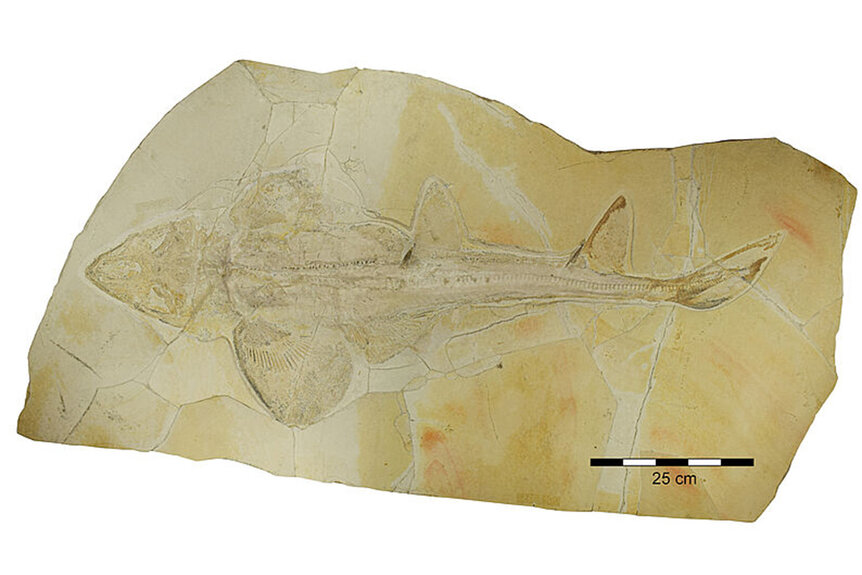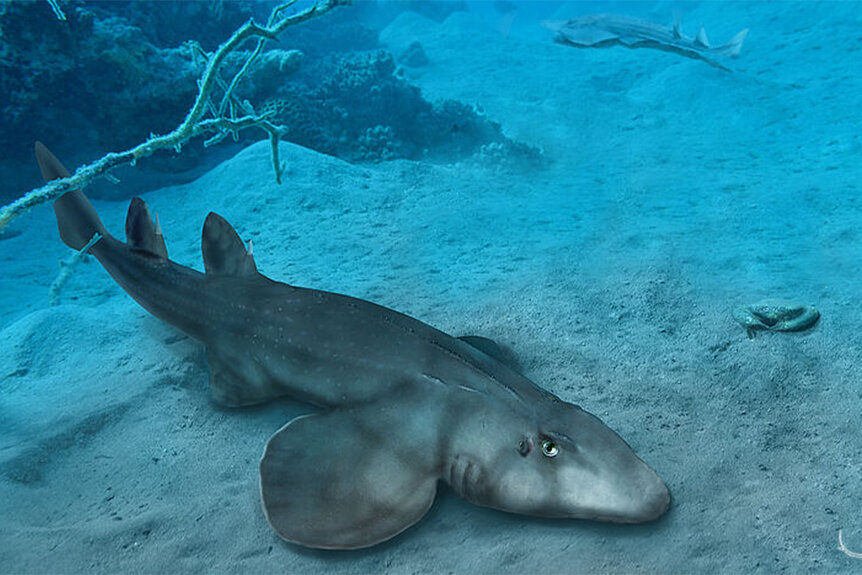Create a free profile to get unlimited access to exclusive videos, sweepstakes, and more!
Welcome… to Jurassic Shark! 150-million-year-old fossil illuminates shark evolution
You're gonna need a more evolved boat.

When we imagine plants and animals from the deep past, we are necessarily doing so with incomplete information. A quick comparison of dinosaur illustrations from today and a few decades ago will reveal that the way we envision extinct animals changes over time, with each new piece of information. And that’s true of sharks as much as anything else.
Before we plunge any deeper into the prehistoric waters, a bit of housekeeping. That bad boy up there from Jurassic World (streaming now on Peacock!), that’s a mosasaur, not a shark. It did live during the Jurassic, but it is not a shark. Mosasaurs were aquatic reptiles which filled some of the same niches as modern whales and other cetaceans. Sharks are considerably older.
RELATED: Great whites might have pushed megalodons toward extinction
The first shark-like animals emerged in the world’s oceans sometime between 420 and 450 million years ago. Sharks are older than land vertebrates, older than trees, older even than the rings of Saturn. Most of what we know about those ancient sharks comes from the fossil evidence they left behind, and they left a whole lot of them. Shark fossils are in fact among the most common fossils found all over the world, but they are limited.
Because of their mostly cartilaginous bodies, sharks don’t fossilize well. The semi-hard parts of their bodies break down before they have a chance to get mineralized. The only parts of their bodies which are hard enough to be regularly preserved are the teeth. And because sharks pump out teeth like they’re being paid for it, there are a lot of them to be found. While teeth are great for letting us know when and where sharks existed, there’s only so much they can tell us about what ancient sharks looked like or how they lived. That has left paleontologists to speculate and argue about the evolution of sharks and their close evolutionary cousins, the rays. Now, new fossils of the Jurassic-era shark Protospinax annectans are changing our understanding of shark and ray evolution.
“The fossils described in our study were all from the area around Solnhofen and Eichstätt, two small towns in Bavaria, Southern Germany. Unfortunately, most of these fossils come from private traders and the exact quarry in which they were found usually remains a secret. However, all these quarries in the area have one thing in common: exquisitely preserved fossils from the Late Jurassic. Localities like Solnhofen and Eichstätt, which bear fossils with such a unique preservation, are collectively called 'Konservat-Lagerstätten.' Sharks and rays have a rich fossil record which is, however, predominantly known from isolated teeth. In contrast, shark and ray skeletons are only known from a handful of these 'Konservat-Lagerstätten,' which thus provide important windows into the past of this group,” Patrick Jambura told SYFY WIRE.
Jambura was the lead author of a recent study describing the fossils and their place among shark evolution, published in the journal Diversity. For a long time, it has been widely believed that sharks have remained more or less unchanged for the last several hundred million years. Almost as if mother nature produced a perfect creature which has weathered the extremes of Earthly life for half a billion years, surviving four (possibly five) mass extinction events without blinking an eye.
“Ya know, the thing about a shark, he’s got… lifeless eyes, black eyes, like a doll’s eyes.” – Quint, Jaws.
In addition to teeth, the Bavarian fossils preserve the outline of soft tissues, revealing the body plan of a shark which lived 150 million years ago. Surprisingly, researchers found an animal which was highly adapted and specialized for its environment. Most sharks, both modern and ancient, have sleek bodies with two dorsal fins, a heterocercal tail (one in which the bottom fin isn’t as large as the top one) and several billion (maybe not that many) teeth.
By contrast, Protospinax annectans has massive pectoral fins as well as dorsal fin spines, diverging from the standard plan pretty dramatically. The species also had specialized teeth adapted for crushing hard-shelled prey like crustaceans and mollusks. Those teeth diverge from the so-called primitive sharks, further supporting the notion that P. annectans was highly adapted.
“When we talk about sharks, we usually have this picture of an ancient group of animals that has hardly changed through time, because they didn’t need to change in order to survive. But if we are looking at fossils like Protospinax, it is obvious that this is not true – sharks have changed through time, quite significantly in some cases, and have developed different strategies to adapt to a constantly changing environment. Fossils like Protospinax highlight that this adaptability is apparently the key to their success and that this group has not been in some kind of evolutionary stasis,” Jambura said.
RELATED: Steven Spielberg ‘truly’ regrets demonization of sharks and harmful sport fishing caused by ‘Jaws’
In the future, Jambura and colleagues are planning to expand their work to incorporate additional species not just from the Jurassic, but from even older periods. Tracing the trajectory of sharks all the way back to the beginning could reveal how they have managed to survive for so long when so many of their contemporaries have vanished.
“This way, I hope to get a better understanding of trait evolution and which traits aided sharks and rays to survive past extinction events. Knowledge that in the light of the ongoing sixth mass extinction is essential for our planning of the future,” Jambura said.
There are plenty of highly adapted Jurassic-era animals waiting for you in Jurassic World, streaming now on Peacock!




























